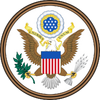| ||||||
| Capital | Havana | |||||
| Other Cities | Camagüey, Holguin, Santiago | |||||
| Language Official |
English and Spanish | |||||
| Others | French, Haitian Creole, Italian | |||||
| Religion Main |
Catholics and Pentecostals | |||||
| Others | Baptists, Muslims, Santerias | |||||
| Ethnic Groups Main |
Germans and Spaniards | |||||
| Others | African Americans, Italians | |||||
| Demonym | Cuban | |||||
| Established | December 10, 1898 | |||||
| Admission | February 14, 1912 | |||||
| Time Zone | EST (UTC-5) | |||||
| Summer | EDT (UTC-4) | |||||
| Abbreviations | US-CU, Cub. | |||||
The State of Cuba (Spanish: Estado de Cuba), colloquially known as Cuba, is one of the 45 states which makes up the United States of America. Located within the Caribbean, the state has a maritime border with Florida to the north, Haiti to the east, and the West Indies both to the north and south. The island of Cuba is the largest island within the Greater Antilles.
Cuba was originally a Spanish Colony known as the Captaincy General of Cuba (1607-1898). Following the Spanish-American War, the island came under American influence before being completely annexed by the United States in late-1898. Many Cubans were upset by the annexation, as they had hoped to achieve complete independence. Because of this, the Cuban National Party was formed and began a guerrilla war against the Americans. By 1901, the war had ended and the island was placed under military occupation.
Cuba would continue to be occupied until 1909, when outgoing President Theodore Roosevelt ordered the withdrawal of American troops from the island and called for the formation of an official Territorial Government. During the 8 year occupation, the economy of Cuba would begin to boom as thousands of migrates from the Contiguous United States would begin to relocate to the island and American contractors would begin to do business on the island. Because of this massive increase in the islands population, the Territorial Government held a referendum on the islands status and an overwhelming majority voted in favor for statehood.
During the Roaring Twenties with prohibition, Cuba became a hotbed for mafia activity. The mafia was most active in and around the city of Las Tunas. Despite the end of prohibition, the mafia continued to be active across many cities on the island.
| |||||||||||||||||



